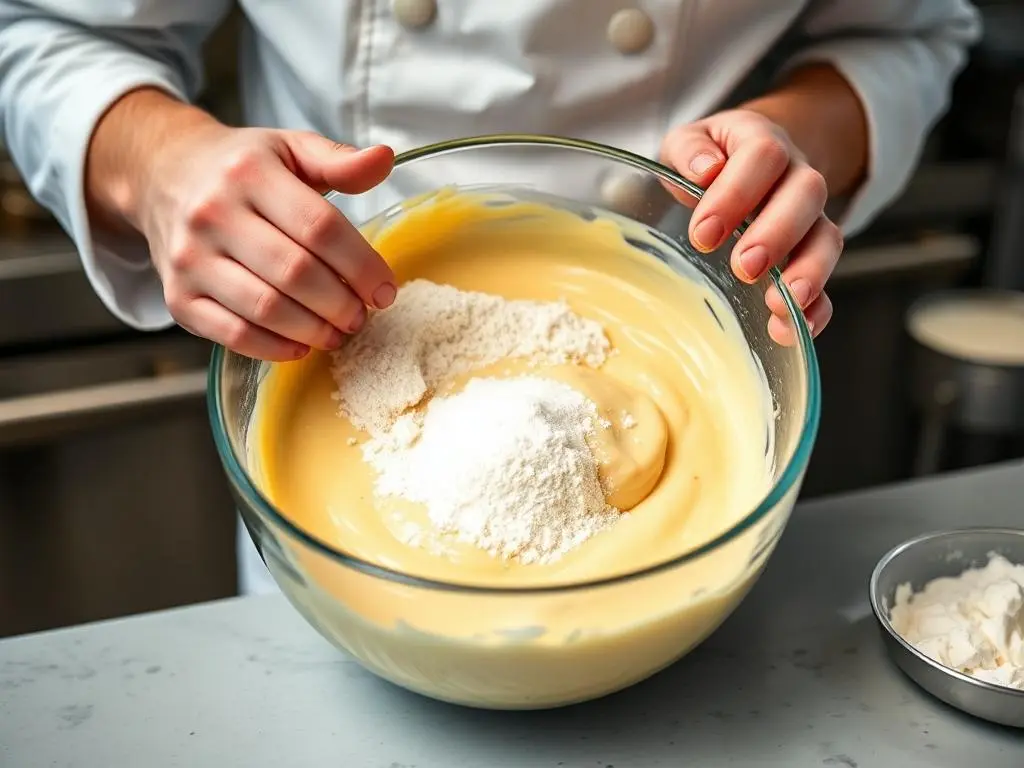Cheese fillings are a delightful addition to many dishes, from stuffed pasta to creamy dips. However, achieving the perfect thickness can sometimes be a challenge. Whether you’re whipping up a cheesy dip for a party or preparing a rich filling for your favorite pastry, knowing how to thicken cheese fillings is essential for a satisfying texture and flavor. In this article, we’ll explore various methods to thicken cheese fillings, the factors that affect their consistency, and tips to perfect your cheesy creations. Let’s dive in!
Introduction to Cheese Fillings
Overview of Cheese Fillings
Cheese fillings are versatile and can be used in a variety of dishes. They can be creamy, rich, and oh-so-delicious! Commonly found in stuffed pasta like ravioli and tortellini, cheese fillings also shine in pastries such as quiches and cheese danishes. Not to mention, they make for fantastic dips and spreads that can elevate any gathering.
Importance of Thickness in Cheese Fillings
Now, why is thickness so crucial? Well, the thickness of your cheese filling can significantly impact the overall dish. A filling that’s too runny might leak out during cooking, leading to a messy plate. On the other hand, a filling that’s too thick can be hard to work with and may not blend well with other ingredients. Striking the right balance ensures that your cheese filling is not only delicious but also easy to handle and serve.
In this article, we’ll guide you through the ins and outs of thickening cheese fillings. You’ll learn about the different types of cheese, the factors that affect thickness, and various methods to achieve that perfect consistency. So, whether you’re a seasoned chef or a home cook looking to impress, you’ll find valuable tips and tricks to enhance your cheese-filled dishes. Let’s get started!
Understanding Cheese Fillings
Types of Cheese Used in Fillings
When it comes to thickening cheese fillings, the type of cheese you choose plays a pivotal role. Different cheeses have unique properties that can affect the texture and flavor of your filling. Here’s a quick rundown of some popular cheese types:
- Soft Cheeses: Cream cheese and ricotta are often used in fillings due to their creamy texture. They can easily be blended with other ingredients, making them a favorite for dips and pastries. However, they can also be quite runny if not handled properly.
- Hard Cheeses: Cheddar and mozzarella are great for adding a robust flavor. These cheeses tend to be firmer, which can help achieve a thicker consistency. They melt beautifully, making them ideal for stuffed pasta and baked dishes.
- Specialty Cheeses: Goat cheese and blue cheese can add a unique twist to your fillings. While they offer distinct flavors, they can also vary in moisture content, so it’s essential to consider how they’ll affect the thickness of your filling.
Common Dishes Featuring Cheese Fillings
Cheese fillings are incredibly versatile and can be found in a variety of dishes. Here are some popular options:
- Stuffed Pasta: Think ravioli and tortellini, where cheese fillings are encased in delicate pasta. The thickness of the filling is crucial here, as it needs to hold its shape during cooking.
- Pastries: Cheese danishes and quiches often feature rich cheese fillings. A thicker filling can help prevent sogginess in the pastry, ensuring a delightful bite every time.
- Dips and Spreads: Cheese dips are a party favorite! A thick, creamy cheese dip can be the star of any gathering, perfect for pairing with chips or veggies.
Understanding the types of cheese and the dishes they complement is essential for mastering the art of thickening cheese fillings. By selecting the right cheese, you can set the foundation for a delicious and satisfying filling. Now that we’ve covered the basics, let’s explore the factors that affect the thickness of cheese fillings.
Factors Affecting Cheese Filling Thickness
Moisture Content in Cheese
One of the primary factors that influence the thickness of cheese fillings is the moisture content in the cheese itself. Cheeses with high moisture levels, like ricotta and cottage cheese, tend to be creamier but can also lead to runny fillings if not managed properly. On the flip side, harder cheeses like aged cheddar have lower moisture content, which can contribute to a thicker consistency.
When selecting cheese for your filling, consider how its moisture content will affect the final product. If you’re using a cheese with high moisture, you might need to incorporate thickening agents or reduce the liquid in your recipe to achieve the desired thickness.
Temperature and Its Effects
Temperature plays a significant role in how cheese behaves during cooking. When cheese is heated, it melts and can become runny. If you’re aiming for a thicker filling, it’s essential to control the temperature. For instance, if you’re mixing cheese with other ingredients, doing so at room temperature can help maintain a thicker consistency.
Additionally, cooling your filling after cooking can help it firm up. If you find your filling is too runny after cooking, letting it cool in the refrigerator for a bit can help it thicken naturally.
Additional Ingredients
The ingredients you add to your cheese filling can also impact its thickness. For example, incorporating eggs can help bind the filling and create a thicker texture. Similarly, adding flour or breadcrumbs can absorb excess moisture, resulting in a more stable filling.
When experimenting with additional ingredients, keep in mind how they will interact with the cheese. Balancing flavors and textures is key to achieving a delicious and thick cheese filling.
Understanding these factors will empower you to make informed choices when thickening cheese fillings. Now that we’ve explored what affects thickness, let’s dive into the various methods you can use to achieve that perfect consistency!
Methods to Thicken Cheese Fillings
Using Starches
Starches are a fantastic way to thicken cheese fillings without altering the flavor too much. Here are two popular options:
1. Cornstarch
Cornstarch is a common thickening agent that can work wonders for your cheese fillings. To use cornstarch effectively, follow these steps:
- Create a Slurry: Mix equal parts cornstarch and cold water to create a slurry. This prevents clumping when added to your filling.
- Incorporate Gradually: Stir the slurry into your cheese filling while it’s on low heat. Keep stirring until the mixture thickens, which usually takes just a few minutes.
Cornstarch is particularly useful for dips and sauces, as it provides a smooth texture without a starchy taste.
2. Flour
Flour is another excellent thickening agent, especially for baked cheese fillings. Here’s how to use it:
- Make a Roux: In a saucepan, melt some butter and whisk in an equal amount of flour. Cook this mixture for a couple of minutes until it’s golden brown.
- Add to Filling: Gradually whisk in your cheese and other ingredients. The roux will help thicken the filling as it cooks.
Using flour can add a slight nuttiness to your filling, enhancing the overall flavor.
Dairy Additives
Incorporating other dairy products can also help thicken your cheese fillings while adding richness.
1. Cream Cheese
Cream cheese is a popular choice for thickening cheese fillings. Its dense texture makes it an ideal candidate. Simply blend cream cheese into your filling until smooth. This not only thickens the mixture but also adds a delightful creaminess.
2. Sour Cream
Sour cream can also be used to achieve a thicker consistency. It adds a tangy flavor that can complement many cheese fillings. Just fold in sour cream to your mixture until you reach the desired thickness.
Gelatin and Agar-Agar
For those looking for a vegetarian option, gelatin and agar-agar are excellent thickening agents. Here’s how to use them:
- Gelatin: Dissolve gelatin in warm water and let it bloom. Then, mix it into your cheese filling. This will help set the filling as it cools, creating a firmer texture.
- Agar-Agar: Similar to gelatin, agar-agar is derived from seaweed and is a great plant-based alternative. Follow the package instructions to dissolve it in water before adding it to your filling.
Reducing Liquid
Another effective method for thickening cheese fillings is to reduce the liquid content. Here’s how to do it:
- Simmer: Cook your filling over low heat, allowing excess moisture to evaporate. Stir frequently to prevent sticking.
- Monitor Consistency: Keep an eye on the filling as it cooks. Once it reaches your desired thickness, remove it from the heat.
This method works particularly well for sauces and dips, ensuring a rich and concentrated flavor.
Blending Techniques
Sometimes, achieving the right thickness is all about how you blend your ingredients. Using a food processor or blender can help create a smooth, thick filling. Here’s a quick guide:
- Combine Ingredients: Add your cheese and any other ingredients to the processor.
- Pulse Until Smooth: Blend until you achieve a creamy consistency. If it’s still too runny, consider adding a thickening agent like cornstarch or cream cheese.
Blending not only thickens the filling but also ensures that all flavors are well incorporated.
Tips for Perfecting Cheese Fillings

1. Balancing Flavor and Thickness
When thickening cheese fillings, it’s crucial to maintain a balance between flavor and texture. A filling that’s too thick might lose its creamy essence, while one that’s too runny can dilute the taste. Here are some tips to strike that perfect balance:
- Taste as You Go: Always sample your filling as you add thickening agents. This way, you can adjust the seasoning and ensure the flavor remains vibrant.
- Use Complementary Ingredients: Incorporate herbs, spices, or other flavor enhancers that pair well with your cheese. This can help elevate the overall taste, even if the filling is thicker.
2. Testing Consistency
Before committing to your filling, it’s essential to test its consistency. Here’s how to do it effectively:
- Spoon Test: Take a spoonful of your filling and let it sit for a moment. If it holds its shape without spreading too much, you’re on the right track.
- Chill and Check: If you’re unsure, refrigerate a small portion of the filling for about 15 minutes. This will give you a better idea of how it will set once cooled.
3. Storage Tips
Proper storage can help maintain the thickness and quality of your cheese fillings. Here are some best practices:
- Use Airtight Containers: Store your thickened cheese filling in airtight containers to prevent moisture loss and maintain freshness.
- Refrigerate Promptly: If you’re not using the filling immediately, refrigerate it as soon as it cools. This helps preserve its texture and flavor.
- Reheat Gently: When you’re ready to use your filling, reheat it gently on low heat. Stir frequently to ensure it warms evenly without becoming too runny.
Thickening cheese fillings can be as simple as adding a bit of flour or cornstarch, or as creative as folding in whipped cream for a lighter texture. If you’re working with cream cheese, you’ll want to explore our tips on how to firm up cream cheese filling and how to make cream cheese filling thicker. For a deeper dive into the differences between cheese-based options, check out our comparison of buttercream vs. cream cheese filling. These resources will help you create the perfect consistency for any cheese-filled recipe.
Conclusion
In this article, we’ve explored the ins and outs of thickening cheese fillings, from understanding the types of cheese to the various methods you can employ. We discussed how factors like moisture content, temperature, and additional ingredients can influence the thickness of your filling. You learned about effective thickening agents such as cornstarch, flour, and dairy additives, as well as techniques like reducing liquid and blending.
Now that you’re armed with all this knowledge, it’s time to get creative in the kitchen! Don’t hesitate to experiment with different cheeses and thickening methods to find what works best for your favorite dishes. Whether you’re making a cheesy dip for a gathering or preparing a rich filling for stuffed pasta, the possibilities are endless.
Remember, cooking is all about trial and error, so have fun with it! Share your experiences and results with friends and family, and who knows you might just create the next crowd-pleaser. Happy cooking, and enjoy your deliciously thickened cheese fillings!
FAQs
1. What is the best cheese for thickening fillings?
When it comes to thickening cheese fillings, cream cheese and ricotta are often top choices due to their creamy texture. However, for a firmer filling, consider using aged cheddar or mozzarella. These cheeses not only thicken well but also add a rich flavor to your dishes.
2. Can I use non-dairy alternatives to thicken cheese fillings?
Absolutely! If you’re looking for non-dairy options, consider using cashew cream or tofu. Blending soaked cashews with a bit of water creates a creamy texture that can mimic cheese. Silken tofu can also be blended until smooth, providing a thick base for your filling without dairy.
3. How do I fix a cheese filling that is too runny?
If your cheese filling turns out too runny, don’t panic! You can thicken it by:
- Adding a Thickening Agent: Incorporate cornstarch or flour mixed with a bit of water to avoid clumping.
- Reducing Liquid: Simmer the filling on low heat to evaporate excess moisture.
- Incorporating More Cheese: Adding a bit more cheese can help absorb some of the liquid and thicken the mixture.
4. Is it possible to thicken cheese fillings without adding extra ingredients?
Yes, you can thicken cheese fillings without adding extra ingredients by allowing them to cool. As cheese fillings cool, they often thicken naturally. Additionally, cooking the filling over low heat can help reduce moisture content, leading to a thicker consistency.
5. How long can I store thickened cheese fillings?
Thickened cheese fillings can typically be stored in the refrigerator for about 3 to 5 days. Make sure to keep them in an airtight container to maintain freshness. If you want to store them for a longer period, consider freezing the filling. Just be sure to thaw it in the refrigerator before using, and reheat gently to restore its texture.

